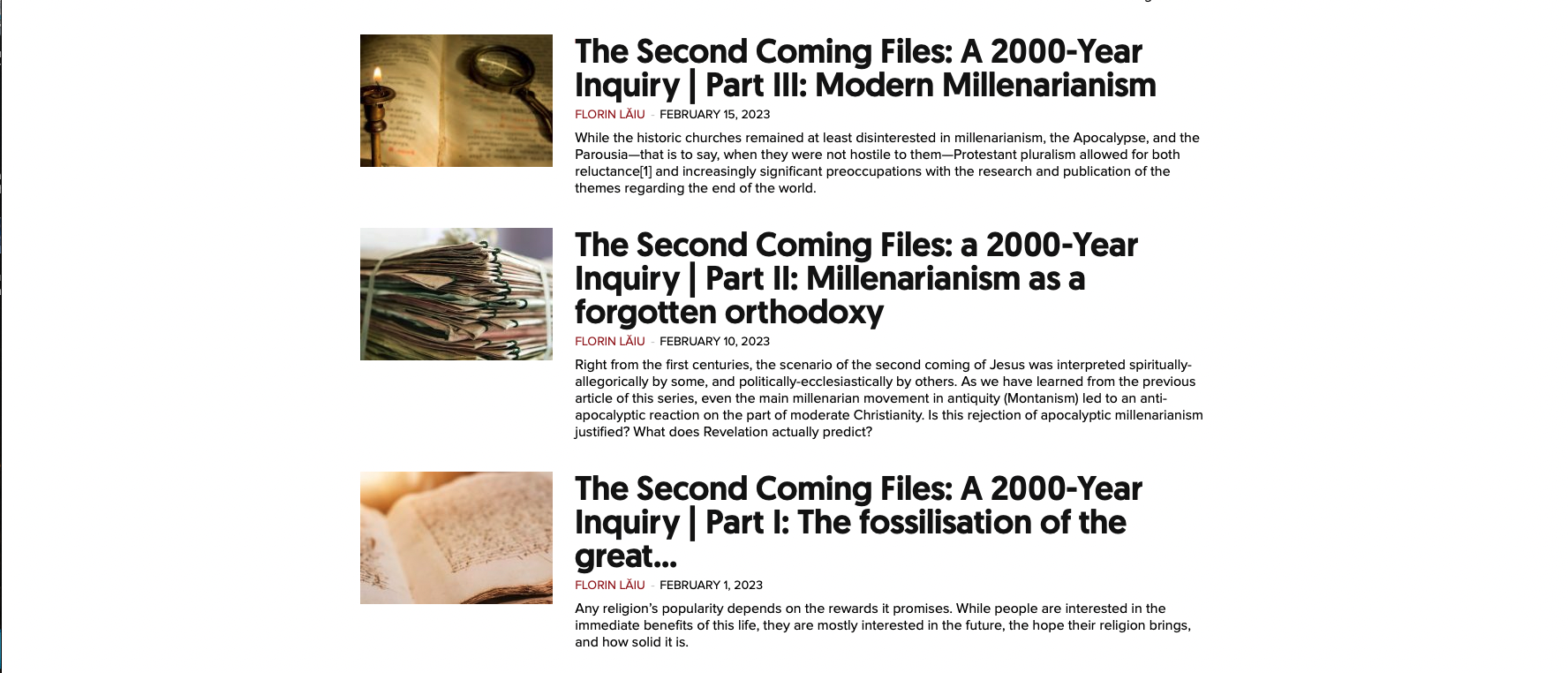The expectation of the soon return of Jesus in 19th century Europe and America has left a path for believers and future believers to tread with confidence. Beyond the imperfect theological understanding of the forefathers, of which no one need be ashamed, God has shown that He can use any material, provided it is consecrated to Him.
In Europe, too, Millenarianism was a movement, or at least a current, that transcended all confessional barriers, disregarding the obstacles imposed by the State Churches. The writings of the German theologian Johann Albrecht Bengel and the Pietist movement were important factors in the spread of the Millenarian phenomenon. The research is far from complete, but it is provocative. Often, the spark of interest among those who began to study Bible prophecy was independent, prompted only by Scripture and supernatural factors.
Millenarian writings in the countries of the Old Continent
In the Netherlands, H. Heintzpeter (Hentzepeter), curator of the Royal Museum and court chaplain, wrote and published about the coming of Jesus in 1847, after a dream about the imminent coming of Christ and after studying J. Petri’s commentary on the prophecies of Daniel.
Some sources say that in Ireland about 100 preachers proclaimed the imminent coming of Jesus. Among them were the Irish Anglican Edward Hoare, who wrote in 1843 about the hope that Jerusalem would be cleansed from the Ottomans, and the Irish Protestant Isaac Ashe, who wrote a commentary on Revelation in 1835.
In 1820, in Scotland, Archibald Mason foresaw the War of Armageddon that would purge the Church and the world of Papism in 1843. In 1844, the Scottish clergyman James Scott published a commentary expressing his belief that the end was near (1844-1847, 1867 at the latest), and was deeply concerned that time was short and that the world was not ready for the coming of Christ.
The Swiss lawyer and parliamentarian Alphonse Nicole wrote a study indicating the year 1846/1847 as to when believers could expect the “cleansing” of the Church. It was published in London.
Between 1834 and 1840, German theologian and professor Johann Heinrich Richter, secretary of the Rhenish Missionary Society, published a six-volume commentary on the Bible (Erklärte Haus-Bibel), for which he received a doctorate in theology from the University of Bonn. He had studied theology at Halle, the academic centre of Pietism. For the prophecies of Daniel, which refer to both the end of the 2300 years and the end of the 1260 years, Richter ended them synchronously in 1847 or 1843. In 1835, German (Bavarian) professor Leonhard Kelber published a book (Das Ende Kommt) in which he corrected Bengel’s calculation (which was for 1836) using Petri’s studies. He claimed that the coming of Jesus would take place sometime between 1843 and 1847, at the end of the 2300 years of Daniel’s prophecy.
European pioneers of Millenarianism
In 1842, Irish Protestant Charlotte Elizabeth Tonna, a prolific writer, fearless campaigner against the Anglican Church’s compromise with papism, editor of the Protestant Magazine and a committed evangelical, began to publish her Millenarian writings. Some of these, including her famous poems “The Maiden City” and “No Surrender,” were condemned by the Catholic Archbishop of Siena and included in the Index Expurgatorius. Her last work, completed on her sickbed while tormented by cancer, was called “War With the Saints” (an allusion to Daniel 7) and described the atrocities of the papal crusaders against the Albigensians and Waldensians. Although she did not give exact dates, Charlotte argued for the imminence of the end and credited the great contemporary millennialists, Eduard Irving and Joseph Wolff, whose influence had converted her to Millennialism.
In 1829-1835, Scottish bookseller and publisher James A. Begg, one of the founders of the Scottish Reformed Society, a Presbyterian layman with a passion for creationist studies, published a series of tracts on the second coming of Jesus, the prophecies of Daniel and Revelation, and the seventh day as a day of rest for the whole world. Long before he was baptised a Seventh-day Baptist (1853), Begg had discovered from the Bible that Saturday was the Lord’s Day, which he then observed for the rest of his life. In 1840, Begg began corresponding with the American Millerite magazine Signs of the Times, where his articles on the Sabbath were rejected. Like the Millerites, he was in anticipation of the end of the 2300 years and the return of Christ between 1843 and 1844.
In Switzerland in 1839, the Swiss Reformed theologian F.S.R. Louis Gaussen also preached the end of Mohammedanism and the world. Regarding the end of time, Gaussen calculated the 1335 years of Daniel 12, from the rise of the papacy in the 6th century to the resurrection of the righteous, around 1843. As early as 1837, Gaussen had begun to write Sunday School studies on the prophet Daniel, which were aimed at children, with the purpose of winning over parents, which he did. He also attracted visitors from other countries, which led him to prepare studies for France as well.
Some of Gaussen’s interpretations are particularly profound. For example, in the prophecy of Daniel 2, he identifies the two elements mixed (iron and clay) as the traditional relationship between state and church from the Roman Empire to the end. Dismissed from the clergy for his critical attitude towards the acquisitive ambitions of the Church of Geneva, Gaussen joined the newly founded Evangelical Society and became a professor of dogmatics alongside Merle D’Aubigné in a new college. He laid the foundations for the inerrantist theology[1] now espoused by all fundamentalist evangelicals with his major work on the inspiration of the Bible (La Théopneustie).
Scandinavia: the preaching epidemic
In 1841, there was an unusual spiritual revival in Sweden and Norway. Probably under the influence of German pietism, some families had embraced the Millenarianism of the age, with its emphasis on the imminent return of Christ, and began to preach. In these countries, however, only clergymen of the state (Lutheran) church could legally preach. Laymen who did not belong to the church were therefore put in prison. Unexpectedly, however, their children, some of them uneducated, took up the task of preaching in a way that aroused the interest of ordinary people throughout the country and the amazement of some elites who could not find a diagnosis for this prophetic epidemic. It was a real charismatic awakening. One of these children would explain much later (1896): “I preached, yes, I had to preach. I had no personal strategy. A force took possession of me and I said what I was forced to say.”
The movement began in the parish of Hjelmseryd in December 1841. Four teenage peasant girls began proclaiming that the end of the world was coming, with no specific date, and that everyone must repent and prepare to meet God. Almost simultaneously, a large number of 10-12-year-old “prophetesses“ emerged in the neighbouring parishes. In the village of Hornborga, six boys between the ages of 8 and 18 were inspired by the Spirit of God to preach the same warning. Thousands of people flocked to hear them. On 6-7 February 1842, a young girl preacher was visited by over 3,000 people. This had not happened since the days of the apostles. The children were called “repentance criers.” Many of the listeners were led to repentance. Within two weeks of hearing the message, 70 liquor producers closed their businesses.
The Swedish press reported on this phenomenon for several years and tried to explain it in psychological and psychiatric terminology, with experts coining the term “preaching sickness.” Sufferers were described as normal, except that they were moved by an invisible force to preach repentance. Following the experts’ verdict, the children were isolated so as not to infect others with this strange disease. Some of the children were even severely punished.
In 1843, Dr Sven Erik Sköldberg, Minister of Health for the province of Jönköping, published a scientific report on the phenomenon,[2] stating that these children “opposed all immoral life, drunkenness, dancing, and all kinds of vices, and asked people to judge themselves in the light of the Ten Commandments. The voices claimed that they were not preachers, but that they were sent by the Lord to call people to repentance, and that no one, not even the angels, knows the exact time of the day of judgement… The calls to repentance which I heard were so pure that no one, with the Bible in hand, could criticise them, much less say they were heresy.”
Dr Sköldberg, however, made some clinical observations about the condition of these children during the sermon, which betrayed his perplexity: “Breath cannot be observed, although they doubtless must breathe.” The famous doctor challenged the greatest theologians and doctors to explain this phenomenon by natural means. He explains that he “had a prejudice, an abhorrence for all these voices and considered them heretical and fanatical spirits…” But in the end, he was “convinced that not a single word that must be spoken when the inner compulsion comes, is dependent on their own choosing—for then the message gushes from their breast like a bubbling spring.” As a result, the doctor came to a perfectly reasonable, if “unscientific” conclusion: “I repent of all my harsh opinions and stand in amazement of them.”
Read the previous articles of this series:
Millenarianism in the Americas in the 19th century
Before describing William Miller’s American Millenarian movement, which will be presented in the next part of this series, it is important to know that many other Millenarian preachers were active in North and Latin America independently, before or in parallel with the Millerite movement. Although the fruits of their activity were less spectacular, the spiritual adventure itself and its Christian quality are still worthy of admiration today. Readers may be surprised by personalities they neither knew nor expected.
North America
Between 1811 and 1828, Presbyterian theologian William C. Davis of South Carolina, Baptist theologian Charles Wheeler (president of a West Virginia college and a former classmate of the famous missionary Adoniram Judson), and theologian Dr Joshua L. Wilson, moderator of the Old School General Assembly, wrote about the end of the 2300 years and the cleansing of the church as falling in 1843-1844 or 1847.
In 1829, the Scottish-American Alexander Campbell, a pioneer of the American Restoration Movement and president of Bethany College (Virginia), published his debate with the learned atheist Robert Owen. Campbell, who was educated in the spirit of the Enlightenment and became a great evangelical apologist, debated the chronological prophecy of Daniel 9, which he dated to 453 BC. Like his contemporaries, he synchronised the 490 years with the 2300 years up to about 1847, when the “purgation of the Christian Church from antichristian abominations”[3] was to take place.
Along with Barton Stone, Campbell is an illustrious founder of the “Church of Christ” (Disciples of Christ or Christian Church), a fellowship related to the Plymouth Brethren.[4] In 1830, Campbell founded the Millennial Harbinger magazine to promote his Millenarian commentaries. Like most commentators, Campbell interpreted the arrogant horn of Daniel 7 to be the papacy, a subject on which he famously debated with Catholic Archbishop J. B. Purcell.
In 1833-1844, Samuel McCorkle, a layman of the Disciples of Christ in Tennessee, published a series of apocalyptic articles and eventually a book under the title Signs of the Times, with Campbell’s publishing company, in which the 2300 days of Daniel ended in 1843/1844 or 1847. The American Baptist doctor and pastor Robert Scott, a devoted friend of John Wesley, published two of his books on millennial prophecy in 1834, a few months before his death, after 50 years of research. The scenario he foresaw for the end of this world in 1843 was specifically dispensational—that is, he expected the national restoration of the Jews to Jerusalem and their conversion at the coming of Jesus at the beginning of the millennium.
Boundless passion
In 1831, Harriet Livermore, one of the best-known interfaith preachers and missionaries in 19th-century America, published 2000 copies of Joseph Wolff’s “Millennial Tidings.” She began preaching the conviction of the imminent return of Jesus as set forth in the writings of Edward Irving and Joseph Wolff, and announced the beginning of the millennium in 1847 with the arrival of Christ on the Mount of Olives. Harriet was a woman with an excellent education who had been part of Washington’s high society. She was motherless, and her father and grandfather had been state representatives. Some authors believe that John Whittier dedicated the poem “Snow Bound” to her.
Miss Livermore was brought up in the Congregational faith, but had no interest in religion until the age of 18. She devoted herself to religious life, study, and preaching after her fiancee died of yellow fever. She wrote that “neither fears of hell, nor desires for Heaven” made her repent, but that she was “tired of the vain, thoughtless life [she] had led, sick of the world, disappointed in all [her] hopes of sublunary bliss.” She took a particular interest in the Indian people, believing them to be the descendants of the ten “lost tribes”—a fantastic idea borrowed from Joseph Wolff and echoed by the authors of the Book of Mormon around the same time. The Osage Indians called her “God’s woman” (Wahkondas Wakko). After Harriet began evangelising the Indian people, government officials opposed her project.
Livermore preached to Episcopalians, Methodists, Dunkers, Baptists, Christian Connection, and so on. She spoke to the unfortunate in asylums and prisons. The press treated her well. She was invited to address Congress (1827, 1832, 1838, 1843), where she called presidents and congressmen to repent in the face of the approaching end: “The judgement cannot miss Washington!” Audiences praised her as an eloquent speaker, with an accurate and persuasive speech that moved hearts to tears. She had a very melodious voice and, in good evangelical tradition, ended her sermons with a song, leaving a lasting impression. Harriet also spoke in state legislatures. She also visited Europe, Jerusalem, and Egypt.
Harriet Livermore also put her faith into poetry. Her volume of 1835 (The Harp of Israel), though lacking in poetic genius, reflects a talent at the service of the Millenarian message. Although there is no evidence that Harriet Livermore observed the Sabbath, there is a special interest in the subject in her writings. For example, she noted that at the Council of Laodicea (360 AD) the spirit of the Antichrist manifested itself in two acts of usurpation and blasphemy: Revelation was rejected from the canon, and the Sabbath time was changed. Thus Laodicea (referring to the message of Revelation 3) “have violated the law of God, by profaning His holy things; and have hid their faces from the Great and Glorious Sabbath of the Lord… and the Lord kept silent a long time” (an allusion to Isaiah 42:14 and Psalm 50:21).
In 1835, the Canadian missionary Adam Burwell published “A Voice of Warning,” in which he predicted, among other things, the return of Jesus by 1847 at the latest. In 1841, the Presbyterian minister George Duffield, an American theologian and anti-slavery campaigner, began publishing his Millenarian studies, which brought him into conflict with the renowned professor Moses Stuart (Andover). In 1840, Duffield corresponded with Joshua Himes and concluded that he was in agreement with the Millerites on many points.
In 1842, the American theologian Richard C. Shimeall, Rector of the Free Episcopal Church in New York, who had done serious research into Millenarian theology and the Bible, projected the coming of the Lord for 1847. Shimeall opposed the Millerite movement because Millerites did not expect the general and automatic conversion of Jews at the coming of Jesus.
In 1843 the American Presbyterian J.P. Wheethee, president of Beverley College (Ohio), expressed his belief that the premillennial return, resurrection and judgement of Jesus would soon take place. In the same year, James Shannon, president of Bacon College (Kentucky), published in the Millerite periodicals his belief that the prophecy of Daniel, as explained by William Miller, would be fulfilled between 1843 and 1847. Presbyterian minister John Robinson of Cincinnati, Ohio, unconnected with the Millerite movement, published a tract stating that the papal Antichrist would soon fall and that the end would come in 1843-1847.
Latin America
In 1835, after many years of study and writing, the Mexican Catholic magistrate José María Gutierrez de Rozas published a 235-page theological treatise on the Second Coming of Jesus Christ, in which he warned that the Church was wrong about the theology of the Second Coming. He applied the day=year key to the prophecy of Daniel 9, synchronising it with the 2300 years in Daniel 8 that were to pass before the destruction of the Antichrist in 1847, showing that Antiochus Epiphanes was merely a type of the Antichrist. De Rozas, like the Millerites and some other Millennialists, claimed that the coming of Jesus before the Millennium of the Apocalypse would bring about the catastrophic end of this world as described in 2 Peter 3. He saw the great meteor shower of 1833, visible throughout Mexico, as a sign of the end.
De Rozas remained a devout Catholic throughout his life. He believed in the dogmas of the Church and identified the locusts of the Apocalypse with Protestant schismatics. As well as being a good professional, he was also an honest man. In 1803, the King of Spain knighted him and appointed him a consultant to the Infante Don Pedro. In 1804, he was appointed defence attorney for the prisoners of the Tribunal of the Inquisition; in 1816, he was appointed fiscal lawyer of the Inquisition’s finance department; in 1821, he was appointed member of the Mexican Supreme Court and, after the dissolution of the Inquisition, judge of the Supreme Court of the Federal District.
As a defence lawyer for Inquisition prisoners, José de Rozas had to study the dissident literature they distributed, including the De Vence Bible and the writings of Lacunza, which aroused his interest in the subject of the coming of Jesus and apocalyptic prophecies. In 1848, just before he died at the age of 79, De Rozas published, under a pseudonym, an apology of Lacunza’s writings in which he defended Lacunza’s biblical orthodoxy regarding the imminent coming of Christ. The magistrate theologian claimed that Lacunza had been a good Catholic, but had not been understood, and that his work should not have been put on the Roman Index Prohibitorum.
A great man with a great heart
In 1820, in Argentina, the lawyer Francisco Hermogenes Ramos Mejía, a graduate of the Royal and Pontifical University of Peru, a revolutionary and defender of the rights of the natives, published a small treatise in the Protestant spirit, deeply influenced by the work of the Jesuit Lacunza, of which he had read a manuscript copy. Ramos Mejía was a wealthy landowner. The modern Argentinean city of Ramos Mejía bears his name. He promoted the settlement and emancipation of the Indians, colonising them on his lands and educating them in a form of biblical Christianity long forgotten by official religion.
Ramos Mejía earned his noble reputation as a heretic by worshipping with the Indians every Saturday, stopping work on his property on the Sabbath, allowing marriages outside the Catholic rules, discouraging the veneration of saints and icons, and rejecting the dogma of transubstantiation, which he condemned as idolatry. His few writings, which include critical references to Lacunza’s work and biblical references, though not of literary value, affirm fundamental Protestant principles.
Angered by Mejía’s behaviour, Argentinian Dominican leaders influenced the Prime Minister, Bernardino Rivadavia, who decided that Francisco Ramos Mejía should refrain from promoting practices contrary to the religion of the country and from causing scandal affecting public order, thus tarnishing his reputation and that of his family. Confronted on the subject of Indian emancipation policy, Ramos Mejía and his family were imprisoned and ill-treated.
Ramos Mejía died of the plague in 1828, aged only 54. While the family waited for permission to bury him, the Indians snatched his coffin and disappeared with it into the Pampas in an impressive procession. It is not known where he was buried. The historian and lawyer Francisco Ramos Mejía and the sociologist and psychiatrist José María Ramos Mejía, great cultural figures, are great-grandchildren of the noble social and religious reformer Ramos Mejía.
Without having exhausted our research—having met the personalities who promoted the “Gospel of the Kingdom” in writing, word, and deed in the British Isles, Europe, North America, and Latin America, and having been impressed by the number and quality of these heroes of the faith—we are ready to follow and understand the most striking episode in the history of modern Millenarianism: the Adventist movement initiated by William Miller (Millerite Movement).
Florin Lăiu is a former Bible professor at the Theological Seminary of the Adventus University in Romania where he worked for 28 years, specialising in biblical languages, biblical exegesis, apocalyptic and biblical translation. Now retired, he is an Adventist apologetic, poetry and music enthusiast, author of articles and books, husband, father of four, and grandfather of six.




















